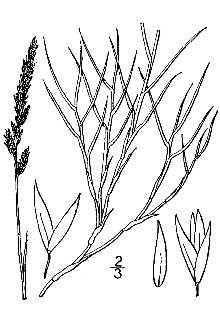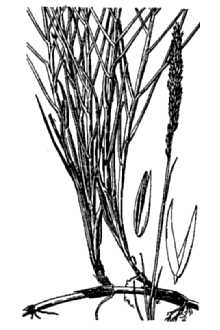Agrostis virginica L.
Scientific Name: Agrostis virginica L.

| General Information | |
|---|---|
| Usda Symbol | AGVI8 |
| Group | Monocot |
| Life Cycle | Perennial |
| Growth Habits | Graminoid |
| Native Locations | AGVI8 |
Plant Guide
Use a soil moisture meter to monitor the soil moisture where Agrostis virginica L. is planted.
Fact Sheet
Alternate Names
Aki aki, aki, mahiki, mahikihiki, manienie, manienie aki aki, manienie mahikihiki, manienie maoli, seashore rushgrass, marshgrass, crabgrass, beach dropseed.
Uses
Conservation: Sporobolus virginicus does very well as a dune stabilizer. It has potential for stream bank stabilization and also roadside slope stabilization. Cultural: In some places S. virginicus is medicinally used to relieve urinary irritation and throat irritation. Wildlife: Many native seabirds find shelter and build nests in coastal stands of S. virginicus. It also provides excellent winter food for wild geese. Forage: S. virginicus has high protein and mineral content and is readily grazed by cattle.
Status
Please consult the PLANTS Web site and your State Department of Natural Resources for this plant’s current status (e.g. threatened or endangered species, state noxious status, and wetland indicator values).
Description
Sporobolus virginicus is a low-growing vigorous perennial grass that spreads by rhizomes. The height ranges from 4 to 8 inches tall. Roots can grow down to 18” deep. Leaves are 1-4” long and 0.04-0.12” wide with distinctly two-ranked and salt crystals common on leaves and stems. The leaf sheath is overlapping and hairy at the throat. Its inflorescence is dense and spike-like. The panicle, 3” long, is shorter than other Sporobolus species.
Adaptation and Distribution
Distribution
Distribution
S. virginicus is commonly found in coastal dune habitats and it does best if sea water level fluctuates from 2 inches above soil surface to 6 inches below. It also does well in a variety of different soils from clays to sands. Being a plant that is adapted to low rainfall and high salinity, S. virginicus is fairly wide spread throughout the tropical regions and is native to the Pacific Islands Region as well as the continental United States. It also occurs in Africa, western seaboard of India, Sri Lanka, and Australia.
Establishment
Although S. virginicus does produce seed, very little of it is viable. The only practical way to propagate it is by vegetative rhizomatous slips. Actively growing slips should be selected for propagation. Cut back increase-plots to initiate active growth. Cut rhizomatous slips 3-4’ long and plant in sterile, well drained medium such as Sunshine4TM potting mix which has worked well. Place propagules under 50% shade and keep planting medium moist. Once the slips begin to take, it is recommended that time-
Management
Sporobolus virginicus is a low maintenance conservation plant. Because it is very drought tolerant, water requirements are relatively low. It is recommended, though, that irrigation be applied during the first 1-2 months after transplanting to help establish plots. S. virginicus is also adapted to low fertility soils, although nutrient amendments according to soil tests would be beneficial for rapid establishment. If forage production is desired, no more than half of the growth should be removed by grazing. Summer grazing deferments of at least 120 days are important to maintain good vigor. Controlled burning of this grass will result in lush, tender forage for winter grazing. Burning should be done no more than every 2 years. Allow 4 inches of re-growth after burning before grazing.
Pests and Potential Problems
Despite its wide range throughout subtropical and tropical regions of the world, S, virginicus it believed to be pest free, Use soil moisture sensors to measure the soil moisture of Agrostis virginica L..,
Environmental Concerns
None. Cultivars, Improved, and Selected Materials None available at this time. No known commercial source.
Plant Traits
Growth Requirements
| Temperature, Minimum (°F) | 17 |
|---|---|
| Adapted to Coarse Textured Soils | Yes |
| Adapted to Fine Textured Soils | Yes |
| Adapted to Medium Textured Soils | Yes |
| Anaerobic Tolerance | Medium |
| CaCO3 Tolerance | High |
| Cold Stratification Required | No |
| Drought Tolerance | High |
| Fertility Requirement | Medium |
| Fire Tolerance | Medium |
| Frost Free Days, Minimum | 365 |
| Hedge Tolerance | None |
| Moisture Use | Low |
| pH, Maximum | 8.0 |
| pH, Minimum | 6.0 |
| Planting Density per Acre, Maxim | 16000 |
| Planting Density per Acre, Minim | 1000 |
| Precipitation, Maximum | 40 |
| Precipitation, Minimum | 20 |
| Root Depth, Minimum (inches) | 18 |
| Salinity Tolerance | High |
| Shade Tolerance | Intermediate |
Morphology/Physiology
| After Harvest Regrowth Rate | Moderate |
|---|---|
| Toxicity | None |
| Resprout Ability | No |
| Shape and Orientation | Decumbent |
| Active Growth Period | Year Round |
| Bloat | None |
| C:N Ratio | High |
| Coppice Potential | No |
| Fall Conspicuous | No |
| Fire Resistant | No |
| Flower Color | Brown |
| Flower Conspicuous | No |
| Foliage Color | Green |
| Foliage Porosity Summer | Moderate |
| Foliage Porosity Winter | Moderate |
| Fruit/Seed Color | Brown |
| Nitrogen Fixation | None |
| Low Growing Grass | Yes |
| Lifespan | Long |
| Leaf Retention | Yes |
| Known Allelopath | No |
| Height, Mature (feet) | 2.0 |
| Growth Rate | Moderate |
| Growth Form | Rhizomatous |
| Fruit/Seed Conspicuous | No |
| Foliage Texture | Medium |
Reproduction
| Vegetative Spread Rate | Moderate |
|---|---|
| Small Grain | No |
| Seedling Vigor | Medium |
| Seed Spread Rate | Slow |
| Fruit/Seed Period End | Fall |
| Seed per Pound | 2000000 |
| Propagated by Tubers | No |
| Propagated by Sprigs | Yes |
| Propagated by Sod | No |
| Propagated by Seed | No |
| Propagated by Corm | No |
| Propagated by Container | Yes |
| Propagated by Bulb | No |
| Propagated by Bare Root | No |
| Fruit/Seed Persistence | No |
| Fruit/Seed Period Begin | Summer |
| Fruit/Seed Abundance | Low |
| Commercial Availability | Routinely Available |
| Bloom Period | Summer |
| Propagated by Cuttings | No |
Suitability/Use
| Veneer Product | No |
|---|---|
| Pulpwood Product | No |
| Post Product | No |
| Palatable Human | No |
| Palatable Graze Animal | Medium |
| Palatable Browse Animal | Medium |
| Nursery Stock Product | No |
| Naval Store Product | No |
| Lumber Product | No |
| Fodder Product | No |
| Christmas Tree Product | No |
| Berry/Nut/Seed Product | No |

